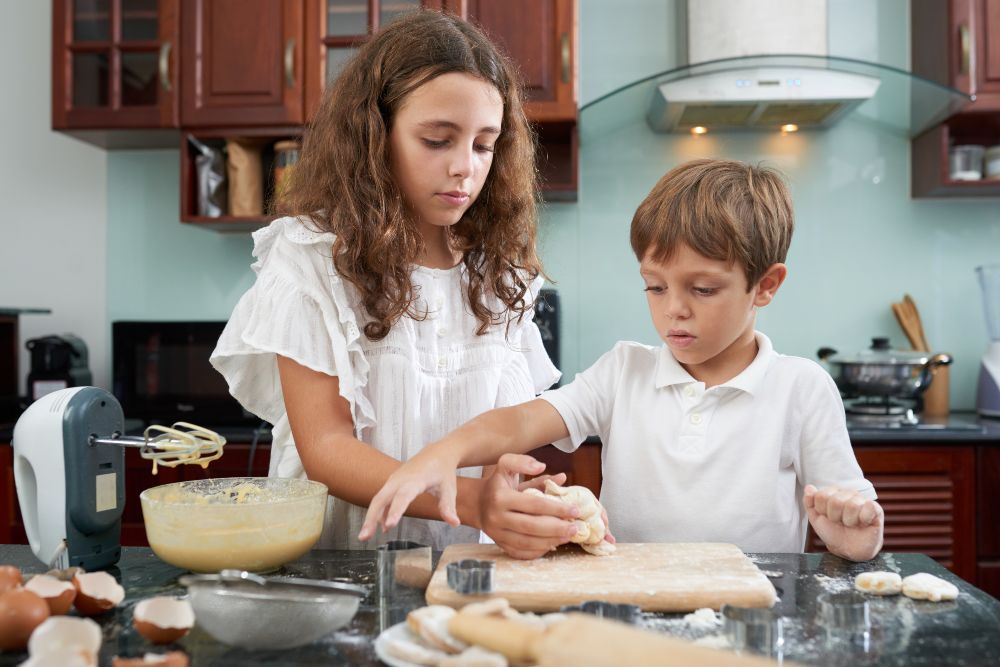
SSUCv3H4sIAAAAAAAACnRUTW/bMAy9D9h/CHyuAX1L7g8oehmw+7CDvpwIta3AljcURf/7aDtylCw9GDAfqfdIitTH92+HQ2X0FGz1fPhYLLBD181TGnUKcQAYPV3w0Q/OjyXiXUhxDLorQaOTPQ269wAOc9ct8OfqrKak0zz5qRDDhI4t2HQ/Ho5TivbtfIoplg43et1PKazEO9pCVBc0QDhD2kXjV44FLeStTv4I+d4kkKv/tdmH7FidcAJc1U8fz52vngrPNJvF86L70C2E2bVJfcHzCqk6/T49YvoRJuu7Tg8+zgXd9vN7r+3oB/t+Tf++L3sVS2txcyOEG3RrE7nrZIEHF1BSPmjES4zuSrP9fBZNH33n9XbnF6ZKGIEkQbpuCGtqZhCulVaypk4ZL1vvjTBZo1KUW+GNq0XbkJo1mta6NawmmHJjsLMtEXuw4ZgQxETtvVA1I8pBcNPWnkvkmLENR+0e3CLqkUWi5hhImWxFrS2BhFpkCOWiZZSvlW3Nqd7+Jj/26+xcatOzC7GYpT/R6m4JoEUDzmOwYTgWx2I6rXuUj9k4D2lcbrXak+tiPGsDvX4+tMDpM37S0wThLuPleMPWxr7QGWJa+35hrRzM/2JiSrBUQsLHG6kagqtyP08BeNZ0coLzuYvaeff13GHOsGQYibyYt6u5eTFSX49ZjlHNNSY/DpuPUCIu85W7AbvTh5TuMntATRAiDWcPqQmRjDFx9d1XRgRSkrP/Z3tVCe7mObnTrgj0mSgp993bpUFHH+MQeljqCStoD+JC7mE3WcCdYdhnSdg6kRf9sNRd8YYbgjCvJRYwx5rD0CtYJ4QV9cJriqmAU5//AAAA//8DAHAQsqLuBQAA
Easy Ways to Get Your Kids More Involved in Cooking
Making sure that your kids eat what you’ve prepared may be a little easier if they had a hand in the shopping, washing, chopping, or cooking. Even if your little ones are too small to wield a knife, stirring up the dry ingredients for the cake, biscuits or cornbread can still be fun. Splitting out and using up produce while it’s still fresh can also be a family affair.
Create Grab and Go Packaging
When you get home with your apples and grapes, make them accessible. Put apples on a pretty plate and set it on the table. Rinse grapes and split them out into individual serving bags. Rinse baby carrots, wash and cut up celery, or split out snack crackers into small packs.
Additionally, as many families struggle to find the time or energy to prepare time at the end of a long day, invite your child to join in on some of your food prep for the week. If you make one lasagna for dinner on Saturday and have another in the freezer for Wednesday, talk about food planning for Sunday, Monday, and Tuesday with your child.
Reduce Spill Risk
You only have to clean up one spilled jug of orange juice from under the refrigerator to understand that small containers greatly reduce the risk of a big mess. Invest in reusable containers for beverages that your child can easily manage. Even better, encourage them to use yogurt instead of milk for their muesli packages for breakfast so you can sleep in a bit longer on a Saturday.
By using reusable containers, you can be sure that your child has their own
- milk
- juice
- water
within easy reach. If you have multiple children, consider color-coding the cups and jugs so everyone knows which bottle belongs to which child. After supper, start a routine of collecting all the jugs, dumping what needs dumped, refreshing what needs to be refilled, and talking about food waste.
Create a Kid Drawer
Once you have food split down into manageable containers, use one of the drawers in your refrigerator as the kid drawer. You may have to put a timer on it, but let your child know that anything in there is fair game when they’re ready for a snack. Additionally, let them know that keeping that drawer clean is also their job.
Teaching your child to keep an eye out for spoilage will not only keep them safer, but it will help them avoid food wasting as they get older. Before it’s time to shop again, encourage them to check out that drawer and add any snacks they may be low on to the grocery list.
Water Bottle Routine
Children often are satisfied with juice but may not be getting enough water for their health. If you have a water pitcher or a filter on your refrigerator, consider encouraging kids to keep a personal water bottle filled and within easy reach, perhaps in the snack drawer. Keep this bottle at the front of the drawer so it’s the first thing they see.
Making sure that your child has their own water bottle and encouraging them to start with water, as well as letting them see you with your water bottle at the ready, will encourage a terrific habit that will serve them throughout their lives. For those who prefer countertop water filtration systems, take care to fasten any large filter canister to the wall or to a cabinet to avoid having a small child tip the canister.
Setting the Table and Serving
Try to get even the littlest kids involved in the table setting process. This can mean starting with a good hand wash, carrying silverware by the handles, placing plates gently, and carrying glasses on the outside only.
Allow older kids to dish portions for little ones. Try to make sure that everyone tries at least one bite of every dish. Being brave about trying new foods is behavior that can be rewarded.
Food is one of the great unifiers, and if any good has come out of 2020 it’s that many of us are now eating together as a family on a more regular basis. A child that grows up learning to cook will be a young adult who has the ability to feed themselves and use a budget.


